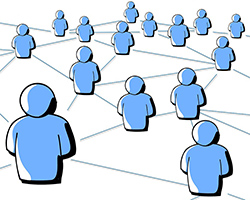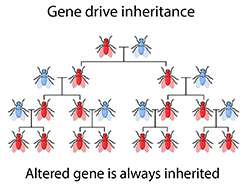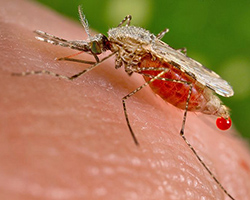You decide that you want to plan a party for you and all of your friends. You have the food, the games, and decorations all planned out. All that’s left is to invite everyone to come over. But how are you going to tell all of your friends?

You could send an individual message about the party to each one of your friends. That would work. But because you have so many friends, it might take a very long time for everyone to find out. It would be quicker to send out a message to just a few of your friends. Then, they could tell your other friends about the party.
So, you decide to send a special message to just a few friends. This message has the party information and one more instruction: to send the message to another one of your friends. Even though you only invited a few friends at first, soon all of your friends will know about your party. This is a lot like how gene drives work.
A gene drive is a tool that forces certain genes to be in a species’ population. Gene drives do this by greatly increasing the chance a certain gene is passed on to an organism’s offspring. So, like with the party invitations, gene drives spread a gene through a species’ population.
Gene Driving School: How Do Gene Drives Work?
Gene drives work by using directed repair gene editing. This enables the insertion of a new gene, called the driven gene, at a particular cut site through the use of a donor template.
Every protein has associated genes that tell cells how to build them, including CRISPR proteins. In a gene drive, both the gene to be spread and genes coding for CRISPR proteins are included in the donor template. The result is that genes for both the driven trait and the CRISPR molecules are inserted at the cut site.

Because a gene drive includes instructions to build more CRISPR proteins, it is constantly editing the genome. It even edits the genes that are passed onto future generations to include the driven gene. As a result, the driven gene will soon be present in an entire population of a species in just a few generations.
Why Would Scientists Want to Use Gene Drives?
One possible use for gene drives is in the prevention of diseases. Diseases like malaria are carried and spread by mosquitoes. Some people hope to use gene drives to reduce the number of mosquitoes that can carry the disease. Fewer mosquitoes would likely reduce the spread of malaria.

One kind of gene drive that some scientists have suggested is to drive genes that cause only male mosquitoes to be born. Now, you’re right in thinking that this wouldn’t spread beyond that generation. If it worked, there would soon be no female mosquitoes for the males to reproduce with. But, that way, the mosquito population would be greatly reduced. Other types of gene drives have also been proposed. They aim to drive genes that would kill mosquitoes during development to reduce populations.
Despite the benefits, some people worry about how these changes would affects the environment. Fewer mosquitoes may prevent the spread of disease. But it may also negatively affect local ecosystems and food webs. Other people raise ethical questions about if people should even try to eliminate a species at all.
Driving Off Invaders
Another possible use of gene drives is to address the challenges of invasive species. Invasive species are species that are not native to an environment (didn't exist there when we first checked). Invasive species can pose serious threats to the native plants and animals that live there. In those cases, gene drives could be used in invasive species to reduce their numbers in a specific population to almost zero. The goal would be to better preserve native species.

But there are several issues with this idea. First, what makes one species belong somewhere more than another? And who are we to decide what species should get to live in one area or another? Using gene drives in this way also raises concerns about long-term effects on the environment. Some people also worry about the ethics of using gene drives to intentionally drive a population to near extinction.
Currently, no gene drives have yet been used in these ways. But there are many scientists that are actively researching gene drives.
Lab mouse image by Rama via Wikimedia Commons.
Read more about: Cutting DNA with CRISPR
Bibliographic details:
- Article: Gene Drives
- Author(s): Dr. Biology
- Publisher: Arizona State University School of Life Sciences Ask A Biologist
- Site name: ASU - Ask A Biologist
- Date published:
- Date accessed:
- Link: https://askabiologist.asu.edu/gene-drives
APA Style
Dr. Biology. (). Gene Drives. ASU - Ask A Biologist. Retrieved from https://askabiologist.asu.edu/gene-drives
Chicago Manual of Style
Dr. Biology. "Gene Drives". ASU - Ask A Biologist. . https://askabiologist.asu.edu/gene-drives
Dr. Biology. "Gene Drives". ASU - Ask A Biologist. . ASU - Ask A Biologist, Web. https://askabiologist.asu.edu/gene-drives
MLA 2017 Style

Be Part of
Ask A Biologist
By volunteering, or simply sending us feedback on the site. Scientists, teachers, writers, illustrators, and translators are all important to the program. If you are interested in helping with the website we have a Volunteers page to get the process started.

